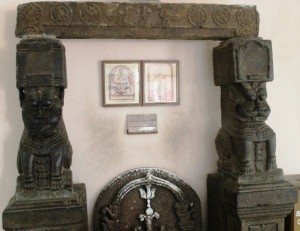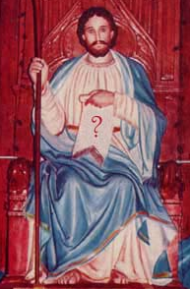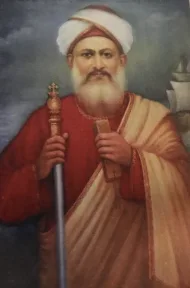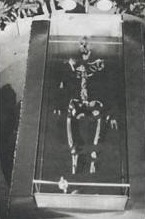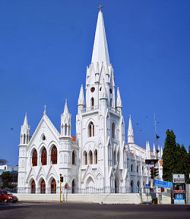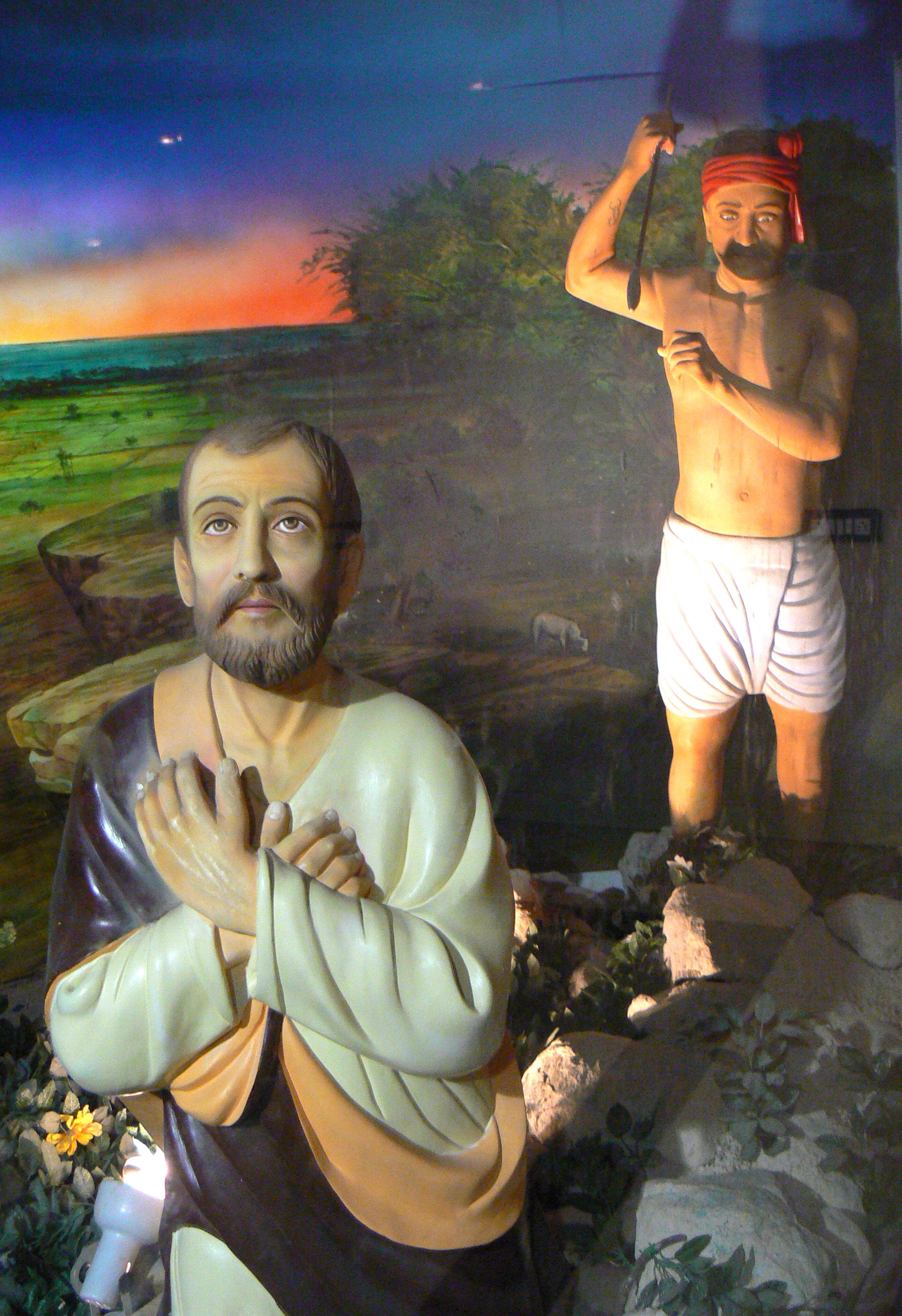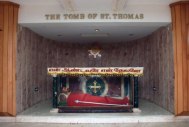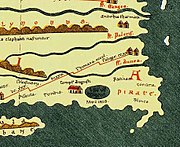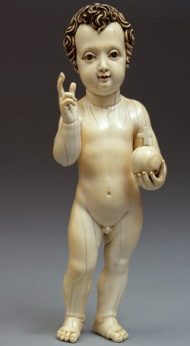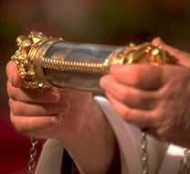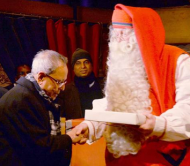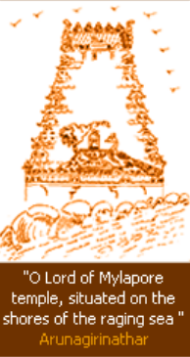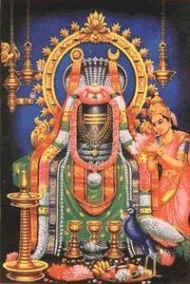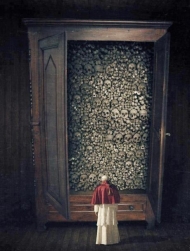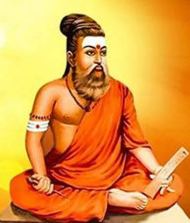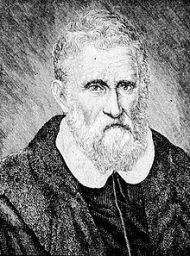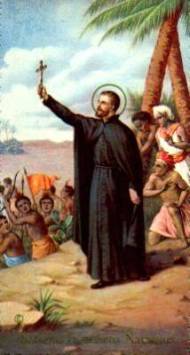“In 1516 Mylapore was under the control of the Portuguese, who had demolished the Kapaleeswarar Temple and built their fort on the spot. … Remains such as pillars, inscriptions and sculptures were found during an archaeological excavation in the Santhome Cathedral in 1923 conducted by the ASI.” – Lakshmi Venkatraman
Increase in population and commercial activities has not changed the status of Kapaleeswarar Temple as the epicentre of the cultural and religious life of Mylapore and its neighbourhood.
Mylapore, in fact, has always been an important place, being one of the 32 holy centres dedicated to Lord Shiva in Thondainadu, comprising the present day districts of Chennai, Kanchipuram and Chinglepet. Now the residents of Mylapore are looking forward to the mahakumbhabhishekham scheduled for August 30, [2004]. The temple has been spruced up and the rajagopuram looks radiant painted in five bright colours. Tamil literature from as early as the sixth century A.D. mentions Mylapore and several poets and authors have written specifically on the temple and Lord Kapaleeswarar and His consort Karpagavalli.
Brahmasirachethamoorthy is one of the forms of Lord Shiva. He got the name after plucking the fifth head of Brahma when the Lord of Creation began considering himself equal to Shiva as he too had five heads. As Siva carried the skull or the kapala He was known as Kapali and the place He dwelt in became Kapaleeswaram. Saint Thirugnanasambandar mentions Kapaleeswaram in his verses. Another reason given for the name is that this temple belonged to the Kapalikas, members of a branch of Shaivism. It is believed that Kapalikas lived in Mylapore and Thiruvottriyur in ancient times.
The present temple is believed to have been built during the 16th century and before that it was near the Santhome Beach. It is believed that the old temple went under the sea during a deluge [in fact the temple was destroyed by the Portuguese and the rubble thrown into the sea–Ed]. Remains such as pillars, inscriptions and sculptures were found during an archaeological excavation in the Santhome Cathedral in 1923 conducted by the Archaeological Survey of India. The inscriptions including one by Raja Raja Chola I also reveal this fact. One of the Thiruppugazh verses of Saint Arunagirinathar (1540 AD) on Lord Singaravelar in this temple also refers to this temple’s proximity to the sea.
The verses of Saint Thirugnanasambandar and Thirumazhisai Azhwar also establish this fact.
In 1516, Mylapore was under the control of the Portuguese, who had demolished the temple and built their fort on the spot.
Some scholars also hold that the old temple was in the same place as the present one and that the latter was rebuilt. The designs of the pillars are in the Vijayanagar style of 16th and 17th centuries AD. The legend connected with the temple goes thus:
Once in Mount Kailash when Lord Siva was giving Gnanopadesam to Goddess Parvati she was distracted by the beauty of a peacock.
The Lord got angry and cursed her to be born as a peacock. When she pleaded for pardon, Shiva said He would join her when the “peacock” worshipped a Sivalingam. After a long period of penance, the peacock found a Shiva lingam under a Punnai tree and worshipped the Lord offering flowers it carried in its beak. The Lord appeared on the scene and the divine couple reunited.
The structure
The Kapaleeswarar Temple follows the general plan of a Shiva temple. The main entrance or the 125-ft tall rajagopuram, built around 1902, faces east. The gopuram facing west next to which is the temple tank is quite small.
The shrine of Lord Kapali faces west against the normal practice of facing east. Of the five faces of Lord Shiva the one facing west is known as Sathyojatham.
On the northern wall of the sanctum sanctorum is the small shrine dedicated to Goddess Durga. On the back wall is the image of Lingodbhava. Opposite to this are arranged images of the sixty-three Nayanmars.
On the southern wall is the shrine of Dakshinamoorthy. The shrine of Karpagavalli, also known as Karpagambal, faces south. Like the heavenly celestial Karpaka tree that grants boons, the Goddess, it is believed, is gracious in answering the prayers of devotees. Karpagavalli worshipping Her lord in the form of a peacock is in a separate shrine on the northern prakaram adjacent to the sthala vriksham, Punnai.
Other important shrines in this temple are that of Narthana Vinayakar in front of the rajagopuram, Saneeswarar on the eastern prakaram and the Navagraha shrine, which is of a more recent origin.
Temple tank
The temple tank with a Neerazhi Mandapam in the middle is on the western side, which is believed to have been built by Mayilai Muthaiappa Mudaliar in the 16th century. The brimming tank with lotus blooms is an enchanting sight to behold. Now, of course because of the drought, it is dry.
However, with kumbabhishekam round the corner, water is being pumped into the tank. The steps were built during the early 1900s. On the western bank near the eight-pillar mandapam is the image of Jyeshta Devi, believed to belong to the earlier temple and was from seventh century AD. There are a few stories regarding this tank. One of them has it that the place belonged to the fakirs and when they were out of town, a Brahmin minister of the Nawab got this tank dug. When the fakirs complained later to the Nawab, he said that both Hindus and Muslims could use it. Another story says that there was a Muslim burial ground. The Nawab gave permission to Muslims to use the tank on the 10th day of Muharram. According to a decree by the Madras High Court, if Muharram and the temple festival fall on the same day, the first preference should be given to Muslims. This practice is continued even today.
Festivals
Several festivals are conducted during the year in the Kapali Temple. Thirugnanasambandar’s Poompavai Padikam (7th century AD) discusses the festivals in ten verses. Not all of them may be held now but many are being held on a weekly, monthly and annual basis, drawing considerable crowd.
The annual Brahmotsavam is celebrated for 10 days and is held during March-April (Panguni) ending with the wedding of the Lord and the Goddess on the day of star Uthram. Devotees across Chennai make it a point to attend the festival, especially Adikaranandi on the third day, Vrishabha Vahana on the fifth, the chariot on the seventh and Arupathumoovar on the eighth. — The Hindu, 27 August 2004

